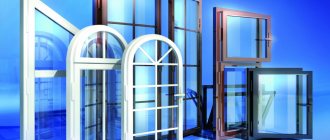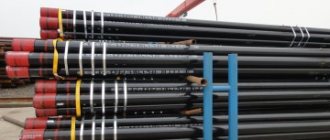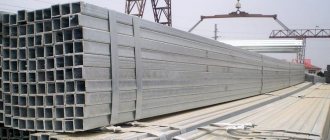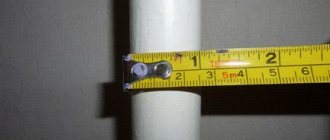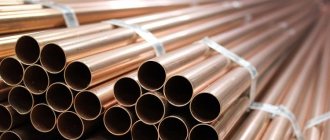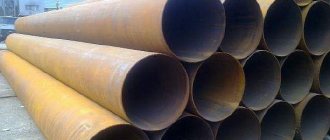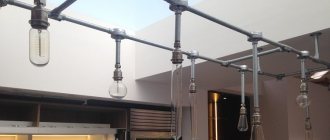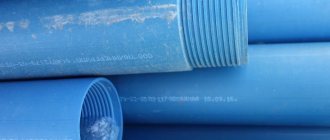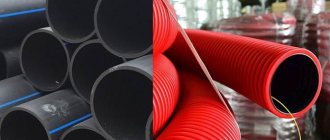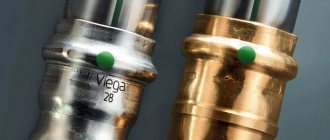Cold-rolled seamless profile pipes have some advantages over hot-formed products. This type of rolled steel has received a wide range of applications in various industries.
Cold rolled seamless profile pipes
Seamless cold-rolled pipe differs from hot-rolled pipe by a higher cost, which is due to the performance characteristics of the products. This type of rolled steel is corrosion resistant, which determines its scope of application.
Seamless profile pipe
Cold-rolled profile pipes with a round cross-section are used in pipelines with high temperatures and pressures of the working environment.
Features of seamless steel pipes
Seamless steel pipes made by cold deformation of metal are able to withstand high internal pressure, temperature loads, chemical and mechanical stress. These products do not have a “risk zone” in the form of a seam. During the production process, they undergo additional processing, which gives the pipes a complete structure, size and geometric shapes.
Advantages of seamless cold-rolled steel pipes:
- perfect compliance with dimensions according to GOST;
- mirror smoothness of the outer and inner walls, which ensures the declared long-term throughput, high aesthetics, and resistance to corrosive processes;
- strength and durability;
- low material consumption, since increased strength (compared to conventional ones) allows the use of thin-walled materials;
- unlimited range of use.
They are used in the manufacture of high-precision medical equipment, in mechanical engineering for the production of engines, in chemical and oil refineries for transporting aggressive liquids and gases.
The disadvantages include the high cost of cold-rolled seamless pipes, which is due to the complex technological process of their manufacture.
GOSTs and cost
The technical characteristics of steel products, the list of which is recorded in GOSTs, depend on the manufacturing method. Therefore, everyone who deals with pipes should be well acquainted with these documents and take into account the recommendations during their installation and operation. Today there are a number of regulatory documents on pipes.
The most popular are:
- rectangular profile pipes made of cold-rolled metal, the range of which is fully described in GOST 8645-68. In particular, this GOST provides for the production of hot-rolled profiles, as well as cold-rolled seamless rectangular pipes. By the way, the latest version of the product is the most durable and reliable. Their significant “minus” is their relatively high cost.
- Seamless cold-rolled pipes regulated by GOST 8734-75. Round seamless cold-rolled steel pipes fall under this state standard. Their production is very similar to the technological process for manufacturing hot-rolled products. But there is also a significant difference, which is that after passing the firmware through the press, the product is subjected to water cooling.
- GOST 10707 80. It lists technical standards for cold-rolled electric-welded pipes with varying degrees of accuracy, which can be of regular, increased, precision types. Products are produced from carbon steel grades with a cross section of 5-110 mm.
- GOST 8639-82. This standard lays out the requirements for profile square steel seamless hot- and cold-rolled, electric-welded cold-rolled pipes, as well as for electric-welded hot-calibrated products. They are produced with wall thicknesses from 0.8 mm to 14 mm with outer diameters from 10 to 180 mm. Their length can be unmeasured, measured and multiple of measured.
- GOST 10706-76 (91). Refers to electric-welded straight-seam steel pipes for general purposes. The document contains requirements for pipes with a diameter of 426-1620 mm.
- GOST 30732-2006. This state standard was approved in 2006. It characterizes steel products with polyurethane foam thermal insulation and a polyethylene shell. Sometimes, instead of polyethylene, you can find protection in the form of a steel coating. Such products are used when it is necessary to lay underground heating networks. According to the document, in such products it is allowed to use coolant with a temperature of up to + 140⁰С at a pressure not higher than 1600 kPa.
Production technology
Cold-rolled pipe materials are produced from hot-rolled blanks by further processing the pipes without heating.
Note! Hot-rolled steel pipes are the raw material for the production of cold-rolled steel.
The production process of cold rolled pipes consists of two stages.
The first is the production of rough blanks using the classical method of hot deformation. Here, a hollow thick-walled sleeve is produced from a metal cast blank, which is hot rolled out on special equipment. The second stage is cold rolling of the pipe blank to give it the required dimensions, geometric shape, and characteristics according to GOST.
We recommend that you read: Seamless thick-walled pipes - types and applications
Scheme of the technological process for the production of cold-rolled seamless pipe:
- the rough blank is cut into the required segments;
- subjected to chemical treatment to remove foreign surface contaminants and scale;
- washed with water, alternating temperature;
- dried at a temperature of 160-180 degrees;
- coated with a special composition that reduces friction of the metal on rolling equipment;
- submitted for rolling cold, the wall thickness is reduced to similar values;
- process the ends of the product;
- By rolling (broaching, drawing, forging - depending on the equipment available at the enterprise), the pipe is brought to the required dimensions, calibrated, and the geometry of the product is aligned;
- finished products are subjected to heat treatment to relieve metal stress and equalize the plasticity and toughness characteristics of the metal.
Cold rolling of pipes makes it possible to obtain high-strength thin-walled products that can withstand significant loads in an aggressive environment.
Areas of use
Due to their performance characteristics, cold-rolled pipes are widely used in various industries. Such rolled products are in demand in aviation, space industry, medicine, etc. Also, profile cold-rolled pipes are used in the manufacture of power units for vehicles and various industrial equipment.
Round cold-rolled pipes and products with other types of cross-sections have an attractive appearance, which allows them to be used in the production of furniture fittings and interior items.
Modern production equipment allows us to produce steel and copper pipes with different characteristics. Cold-rolled seamless profile pipes are relevant in many areas of production. They are resistant to various types of influences, which allows the products to be used under a wide range of environmental parameters.
Advantages of Cold Rolled Steel Pipe
A special cold rolling technology makes it possible to produce stainless steel pipes of small diameters (drip), medium and large.
The advantage of cold rolled pipes is:
- a wide range of products (diameter, wall thickness, geometric configurations);
- exact compliance with the declared dimensions;
- strength.
The cost of cold-rolled seamless products depends on the grade of steel, production technologies, and additives used in the production process. However, the costs are recouped during operation.
Parameters of cold rolled pipes
In accordance with GOST 8734-75, the following types of steel are used for the manufacture of pipes of this category:
- Carbon;
- High carbon;
- Alloyed;
- Highly alloyed.
Only the use of metal grades regulated by GOST makes it possible to achieve high strength of the steel product and resistance to loads. In addition, some industries use cold-rolled pipes made of non-ferrous metals. Copper round drawn and cold-rolled pipes are widely used.
Copper round drawn pipes
Modern equipment is designed to form pipes with a diameter from 0.3 to 450 mm and a metal thickness from 0.06 to 12 mm. The choice of product characteristics is determined by the characteristics of its application.
The difference between a cold-rolled pipe according to GOST and a hot-rolled one is that its production technology makes it possible to obtain thinner walls, and, consequently, a smaller pipe diameter. This significantly expands the scope of application of such products. Cold-formed pipes can have not only a standard round cross-section, but also square, rectangular, oval and even star-shaped.
Classification and standards
The range of cold-rolled pipe products is regulated by GOST 8734-75. This documentation contains tabular data on dimensions: external diameter (from 5 mm to 250 mm), wall thickness, weight of one linear meter of pipe.
Products are classified according to several criteria. Based on the quality of steel, seamless pipe products are divided into the following groups:
- B – medium alloy steel, corresponding to GOSTs 14959 and 18495. Classification according to the chemical composition of the metal.
- B – low-alloy steel GOST 1050 or GOST 4543. Classification according to the chemical composition of the metal plus mechanical strength testing.
- D – the composition of the alloy, mechanical strength, plus additional testing at high temperatures are controlled.
- D – classification according to compliance with operating pressure standards (hydraulic tests). Here the chemical composition of the alloy is not critical.
- E – pipes made of high-alloy steel with control of heat resistance and mechanical strength.
We recommend that you read: How to make a proper brick chimney with your own hands?
Note! Quality control of pipe products is carried out at every stage. The final stage is control of product curvature and wall flattening. All permissible deviations are recorded in GOST 8734 of 1975.
Tubular products are divided into different categories, depending on the format and purpose. The main format classification is the division by wall thickness into:
- extra-thin-walled (more than 35);
- thin-walled (from 13 to 35);
- thick-walled (from 6 to 13);
- especially thick-walled (less than 6).
The division into groups of products according to wall thickness is subject to the mathematical proportions of the ratio of the pipe diameter (outer) to the wall thickness. The values of these proportions for each species are indicated in parentheses.
Note! The wall thickness of a seamless pipe is the main characteristic of its strength. By agreement with the customer, parameters can be changed individually. For example, pipes will be manufactured not according to the outer diameter, but according to the inner diameter, with the ordered wall thickness.
According to the cross-sectional configuration, seamless pipes can be:
- round;
- oval;
- square;
- rectangular.
The dimensions of profile products are characterized by long walls. The minimum size is 50 mm, the maximum is 150 mm.
According to their purpose, cold-rolled seamless pipes are divided into:
- products for special purposes - capillary, high pressure, high precision (GOST 9567);
- conventional - intended for furniture production, construction, installation of communications.
A significant characteristic is the length of the products. It can be measured from 4.5 to 9 m, unmeasured 4-9 m and multiple measured in increments of 1.5 m.
Kinds
Steel
It is impossible to do without cold-rolled steel products either in industrial production or in everyday life. Highways assembled from such products transport liquids and gaseous media. Steel pipes can be used to reliably protect power and signal cables. The products are successfully used in aircraft and automobile construction, oil and gas, chemical industries, and for household purposes.
They differ:
- increased strength;
- reliability;
- ability to withstand internal and external pressures;
- long service life.
The “disadvantages” include the low ability to counteract various types of deposits, as well as corrosion processes.
According to production methods, steel pipes are:
- electric welded, which, in turn, are divided into straight- and spiral-welded, as well as profile and water-gas;
- seamless, which include hot- and cold-rolled.
In order to protect against corrosion, products are subjected to:
- hot or cold galvanizing;
- coating using extruded polyethylene, cement-sand and bitumen mixtures.
The price of cold-rolled seamless pipe depends on:
- conditional passage;
- outer diameter;
- wall thickness;
- steel grade and other technical parameters.
In addition, the cost is affected by the size of the purchase lot (wholesale or retail). Therefore, before you buy cold-rolled pipes, you need to know 100% what products and in what quantity you need.
Seamless
Seamless cold-rolled pipes according to GOST 8734 75 are a type of solid rolled metal, for the production of which special rolling machines are used.
The name says that this product has no seam. Therefore, they are used in conditions with possible increased mechanical, chemical, and thermal influences.
Depending on the production method, the pipe can be:
- seamless;
- hot rolled;
- cold rolled.
Such products have a number of advantages, among which the main ones are:
- increased strength;
- ability to withstand sudden changes in pressure and temperature;
- reliability;
- resistance to mechanical loads;
- resistance to the influence of environments of chemical origin.
You can buy seamless cold-rolled pipe in specialized or online stores.
Square
The construction of bridges, arches, columns, sports and retail premises, and other industrial and domestic buildings cannot be done without rectangular and square cold-rolled pipes. Enterprises engaged in the production of corrugated pipes use steel, copper, aluminum, brass, and other metals and alloys for these purposes.
For the construction of frames, hangars, billboards, furniture elements, stationary greenhouses and conservatories, and other metal structures, no one uses steel, aluminum or copper round drawn pipes, just as no one uses a cold-rolled profile product for installing water supply and heating systems.
Among the many square cold-rolled profile pipes we can highlight:
- trunk type profile. They are used as supporting elements to support large pipelines where there are areas with frequent sudden changes in pressure and temperature. As a rule, such designs are made to order;
- classic professional pipes. With their help, scaffolding and pipelines are constructed. They are indispensable in the construction of protective structures for cables; you cannot do without them if you need to build an irrigation system, a good wicket, gate or fence;
- chemically resistant rolled metal. Such products are used in the pharmaceutical, food, and chemical industries;
- machine-building professional pipes. Such rolled metal is an excellent material for the production of shafts, bearings, cylinders, and piston systems.
Round
The most extensive group of steel pipes, with a rather complex systematization, are round products. The method of production of a product determines its range.
Round cold-formed steel pipes can be:
- seamless. Their production is carried out according to a very similar scheme for the production of hot-deformed products. The difference is that during the production of cold-rolled seamless pipe, water is used to cool the workpiece. Such products are regulated by GOST 8734-75;
- straight-seam electric welded (GOST 10707-91). Products of large diameters are defined in GOST 52079-2003;
- electric welded spiral welded with diameters ranging from 114 mm to 1420 mm. This rolled metal product is used for the installation of oil and gas pipelines. The products are able to withstand pressures up to 9800 kPa at temperatures not lower than -60⁰С;
- gas and water pipes, which are defined by special GOST 3262-75. Usually they come in dimensional and unmeasured types with a length of 4 m to 12 m. In everyday life, thin-walled cold-rolled pipes with a wall thickness of 1.8 mm to 4 mm are used.
Profile
Profile pipes practically cannot be used as fittings for the installation of pipelines transporting liquid or gaseous media.
Rectangular or square parts have a low specific weight. Most often they are used to build frames and connecting parts of various buildings.
They differ:
- increased strength, and therefore reliability in operation;
- low cost compared to other types of fittings;
- ease of installation;
- efficiency;
- ability to withstand high temperature changes.
Retail premises, industrial and residential buildings, warehouses, sports facilities, towers - this is not a complete list of areas of use of profile structures. They are also successfully used in the auto and motorcycle industry, and the furniture industry (especially thin-walled versions).
Thin-walled
Architectural structures, furniture production, very light frames of advertising buildings, household structures - in these and other cases, the use of thin-walled pipes is observed.
They differ:
- strength and reliability;
- plasticity;
- lower cost compared to thick-walled analogues;
- breadth of application.
In addition, such products can easily be welded together, which is very important when installing pipelines.
Both round and profile analogues can be thin-walled. The price of thin-walled cold-rolled pipe depends on many factors. The required choice of a thin-walled product is determined by the scope of its application. When choosing a product you need to consider:
- length and diameter;
- wall thickness;
- steel grade.
Electric welded
Electric-welded pipes are usually used in the installation of water and gas pipelines, both inside and outside buildings.
With their help, a wide variety of rural, town and city main pipeline systems are built, varying in length and diameter. Accordingly, an entire industry has been created that provides the process of installation of electric-welded structures with various shut-off and connecting fittings in the form of flanges, stopcocks, valves, couplings, tees, adapters, elbows, valves, etc.
Not only pipelines are constructed using electric welded structures. They are used to make poles, supports, lighting masts, fences, gates, fences, and other household and industrial structures.
Copper
There is a slight difference in strength and temperature characteristics between steel and copper parts. But still, copper structures have a number of advantages. Drawn cold-rolled copper pipes (GOST 617-90) are characterized by the following properties:
- high anti-corrosion resistance. And if we take into account the increased strength of the connections, the service life of copper parts is much longer than that of their steel counterparts;
- low material consumption. In the production of steel products, the wall thickness is much greater, since it is also necessary to take into account the necessary thickness margin for corrosion processes;
- perfectly smooth internal and external surface. And since there is practically no sediment, tubes of very small diameters can be used;
- when connecting parts, they use the most modern methods, which is technologically important during installation or repair work;
- high reliability of fittings and connecting elements.
Today, Finnish cold-rolled copper pipe is quite popular among consumers, which is usually sold in coils with a total length of 50 m.
Selecting cold-deformed pipe products
When choosing cold-rolled seamless pipes, you should be guided by the compliance of the offered products with GOST 8734-75 and the purpose:
- If the documentation for the pipes does not indicate this document as the main one, then the pipes may be produced with violations. The first thing that unscrupulous manufacturers resort to is a discrepancy between the steel grade, replacement of the material with a cheaper alloy, and non-compliance with the technological cycle.
- The presence of foreign impurities of low-alloy steel in the alloy and non-compliance with production technology leads to a critical decrease in the strength of the pipe. If you choose pipes for the manufacture of especially durable mechanisms, pipelines or structures, then turn to products from trusted manufacturers, where quality will be guaranteed.
- If you need pipes for “ordinary” pipelines, where there is no excess load, then you should pay attention to hot-rolled products with an electric-welded straight or spiral seam. Such pipes will cost half as much as seamless pipes, and their safety margin will be quite sufficient.
- If you purchase pipe products for installation using threaded connections, it is recommended to choose thin-walled pipes.
- For welding work on seamless pipes, gas equipment is used, not electric equipment.
- Thick-walled pipes are pre-prepared before welding - the cut is chamfered. This preparation makes the weld stronger.
- It is recommended to weld medium-thick pipes using direct current. What are the inverter apparatus and corresponding electrodes used for? Such welding will provide the required quality of connection for high-strength pipes.
We recommend that you read: How to correctly and reliably connect a metal pipe to a plastic one?
Classification of types of production of seamless hot-deformed pipes
The classification of the production of seamless hot-deformed pipes is based on three main distinctive features:
- Method for producing a sleeve.
- Method of rolling a sleeve into a pipe.
- The method by which the diameter of the product and its wall thickness are finally formed.
The production process is most fully characterized by the method of rolling the sleeve into a pipe. Pipe rolling units and workshops are named based on this parameter. The method of rolling a sleeve into a pipe can be combined with any method of producing a sleeve, as well as with any method of final formation of the product.
To obtain a sleeve the following can be used:
- Firmware on a cross cutting mill.
- Firmware on the press.
- Press-roll firmware.
- Firmware on a press with a combination of rolling on a cross cutting mill.
How to choose the right riser
Not everyone knows how to choose the right pipe. In order for it to serve for a long time and reliably, you must follow these tips.
Firstly, you first need to familiarize yourself with the operational characteristics, capabilities, and areas of its use.
Secondly, you should choose a seamless product. According to GOST 8734-75, seamless pipes are made of carbon and alloy steel, including stainless steel. This means that only such elements are capable of functioning efficiently over a long period of time, which is approximately 40-50 years, and maybe more. In addition, such risers have great advantages in comparison with analogues. One of the main ones is high resistance to corrosion processes.
Thirdly, you need to decide what type of wall you need: thin-walled or thick-walled.
It is clear that everything depends on the scope of application. For example, if you want to lay a water supply or gas pipeline where the internal pressure of the environment is low, then a thin-walled product is simply irreplaceable.
Thick-walled products are an ideal option for structures that operate under very heavy loads. Therefore, they are often used in boiler plants, petrochemical, and hydrodynamic systems. In such structures, minimal leakage of the working medium is unacceptable and there must be complete sealing. Such risers are used in fairly complex sections of gas and oil pipelines, in processing units, drilling and compressor stations.
How to produce seamless hot rolled pipe
Seamless hot-rolled (hot-deformed, hot-pressed) stainless steel pipe is usually produced on mills operating on the principle of continuous operation.
During the manufacturing process, the seamless structure goes through several stages that are common to units with mills of different types:
- the metal billet is fed into a special furnace and heated to a given temperature;
- to produce a sleeve, a piercing mill is used, a mandrel is inserted into the sleeve and rolling is performed;
- upon completion of rolling, the sleeve is removed and the end of the pipe is cut off;
- the outer surface of the pipe is leveled;
- To carry out reduction, a reduction or continuous sizing mill is used. This procedure is strictly mandatory, as it avoids the appearance of ovality in the product. Large diameter seamless pipe may require the use of an expander;
- Once the product has cooled, it is cut into pieces of the required length and undergoes final finishing.
